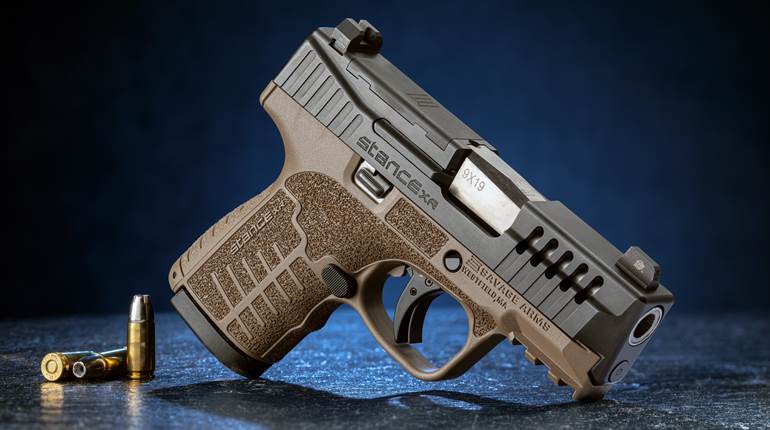
The semi-automatic firearm is so standard now that many accept it as the way firearms have always worked. Truth is, getting a workable semi-automatic was as groundbreaking as the repeating firearm or center-fire primer. Like so many innovations, the semi-automatic firearm is older than most think, but it took a while to work out the wrinkles enough to get widespread attention. Ferdinand Ritter von Mannlicher, an Austrian engineer and small arms designer, is credited with the first semi-automatic firearm—a rifle—in 1885. Mannlicher also designed a number of bolt-action rifles and semi-automatic pistols, as well as the en-bloc clip. The first self-loaders were blowback operated; later on came recoil and gas-operated guns. Let’s examine how each of these systems work.
Blowback
Blowback operation is the simplest of the semi-automatic operations. It relies on a combination of slide or bolt mass and spring tension to keep the slide or bolt in place until the bullet leaves the muzzle. The force generated by the combustion of the powder eventually overcomes the inertia of the slide or bolt, forcing it rearward using the fired case as a sealer. A recoil spring returns the slide or bolt into battery while chambering a new cartridge from the magazine. Because there is no mechanism to lock the bolt in battery, straight blowback-operated guns are relegated to low-power cartridges, primarily rimfires and pistol cartridges up to the .380 ACP.
FAMAS (Wikipedia image)
A variation called delayed blowback is used in guns chambered for more powerful cartridges. Delayed blowback firearms use either a lever or roller to restrain the bolt movement. In a lever-blowback firearm, a lever on the bolt carrier moves toward the rear at a rate faster than the bolt. That lever acts against a surface via a cam or incline that increases the leverage to restrain the bolt, thus slowing its velocity. When the breech pressure drops enough due to the bullet leaving the muzzle, the bolt overcomes the restraints and moves rearward to cycle the action, returning to battery under spring tension. The most familiar to utilize this system is the 5.56 NATO FAMAS (Fusil d’Assaut de la Manufacture d’Armes de Saint-Étienne).
Heckler & Koch G3 (Wikipedia image)
Roller-delayed blowback arms use opposing rollers set into recesses within the bolt carrier, restraining the bolt movement but allowing the carrier to move rearward more rapidly than the bolt until the rollers are cammed into recesses in the bolt, allowing it to move freely. Examples of roller-delayed blowback include the Heckler & Koch G3 rifle and MP5 submachine gun. Roller-delayed arms often have chambers with longitudinal flutes machined into them to allow some of the combustion gases to help dislodge the fired case from the chamber. It seems to be a very dirty operation, but it is remarkably reliable. There are a number of lesser-known types of delayed-blowback operation, but these are the most well-known.

Heckler & Koch MP5 (image courtesy HK-USA.com)
Recoil Operation
Recoil-operated semi-automatics actually lock the bolt to the barrel until the pressure decays to a safe point that the two can separate. Within this category are three sub-categories: long-recoil, short-recoil and inertia operation.
Browning A-5
Long-recoil firearms have the barrel and bolt move rearward as a unit as the gun is fired. They are, in fact, mechanically locked together at this point. As the assembly reaches its furthest point, the bolt is locked while the barrel returns to battery, extracting and ejecting the spent case. When the barrel returns to battery, the bolt is released and returns to battery after picking up and chambering a fresh round. The Browning A-5 and Frianchi AL-48 shotguns, and the Remington Model 8 rifle are long-recoil-operated firearms. The only pistol I know of that utilizes the long-recoil system is the rather arcane and clunky-looking Hungarian Frommer Stop pistol of 1912.
Short-recoil-operated pistols have become a uniform success. They differ from the long-recoil system in that the barrel and slide—the slide taking the place of a bolt in a rifle—are locked together for a short distance before separating. A cam or eccentric link drops the rear end of the barrel so that the locking lugs disengage their recesses in the slide, allowing the slide to continue its rearward travel, extracting and ejecting the spent case. A recoil spring—usually located under the barrel—powers the slide back into battery after stripping a fresh cartridge from the magazine. Virtually all pistols from John Browning’s 1911 to today’s double-action and striker-fired pistols operate on the short-recoil system.
Inertia-recoil-operated firearms are pretty much limited to shotguns. It is most useful in guns generating a substantial amount of recoil and is intended to mitigate the felt recoil of the gun to the shooter, as well as cycling the gun. Inertia-recoil guns feature a two-piece bolt separated by a beefy spring. The front part of the bolt is locked to the barrel. As the gun is fired, the entire firearm moves rearward due to recoil and compressing the spring between the bolt pieces. Once the bolt spring achieves full compression, it has stored enough energy to launch the bolt rearward, while the remainder of the gun remains stationary. The bolt unlocks, the bolt travels to the rear, extracting and ejecting the fired hull, and returns to battery with a fresh shell from the magazine and the bolt spring uncompressed. Benelli used its version of this system some 37 years ago with some success. Browning and Frianchi also fielded inertia versions of their semi-auto shotguns—with the marketing terms “Kinematic Drive” and “Affinity,” respectively—but these were short lived.
Gas Operation
Colloquially referred to as gas guns, these arms utilize a portion of the gases generated during firing to operate the firearm. A port is drilled into the barrel at some point downstream of the chamber and the gas escaping through this port operated a piston or directly impinges on the bolt carrier to provide the energy to initiate movement. Gas impingement is used in Eugene Stoner’s AR-15 rifle. The gases flow through a port several inches down the barrel and flow into a tube in a gas block that is attached to the barrel. The tube transfers the gas to a bolt key attached to the bolt carrier and pushes it rearward to cycle the action against a buffer spring located in the stock.

Top, AK-47; M1 Garand, bottom
Another form of gas operation is the long-stroke piston, where a piston is connected to the bolt carrier, traveling with it throughout the cycling operation. It is a durable and simple way to operate a semi-automatic arm, as well as attenuating recoil in heavier calibers. Examples of long-stroke piston guns are the AK-47 and M1 Garand rifles.
Since we have seen a long-stroke piston, it should follow that there is a short-stroke piston. Also known as a tappet operation, short-stroke pistons are not connected to the bolt carrier group. The gas quickly accelerates the piston which impacts the bolt carrier group sending it rearward. In this system the piston is attached to a connecting rod with a return spring. Short-stroke piston guns are lighter than long-stroke guns because the piston system is far less massive. Most gas-operated shotguns employ this arrangement, as does the M1 Carbine and the Chinese SKS rifles.
M1 Carbine
Few pistols utilize gas operation because the components are bulky and heavy. A noteworthy exception is the Wildey, a modified short-stroke piston handgun capable of handling some intense cartridges. Introduced in 1973, the Wildey is generally thought of as a hunting pistol. It is a semi-custom gun.
Wildey (Wikipedia image)
There are other, more obscure variants of semi-automatic operations—floating chamber, muzzle booster and gas trap come to mind. However, none of them have been widely adopted and are generally relegated to footnotes in the history of firearms design.





































